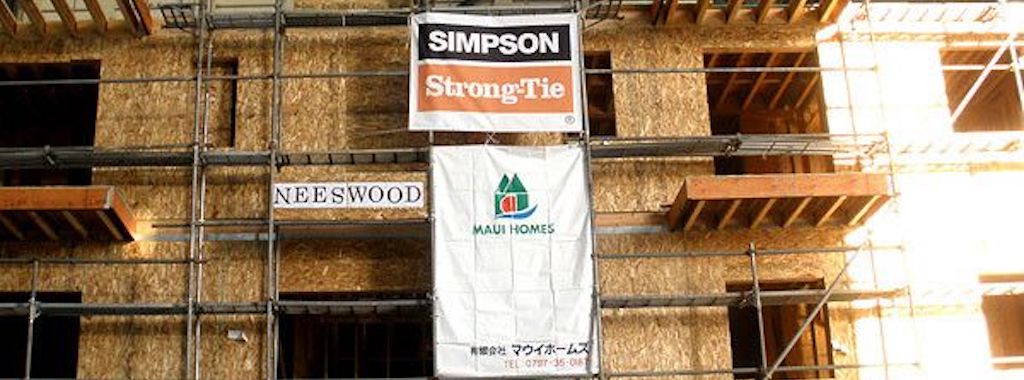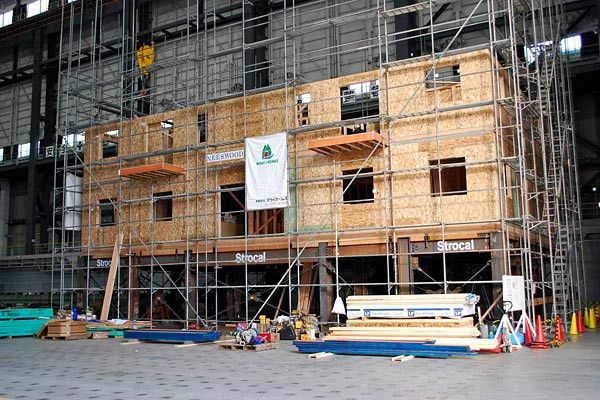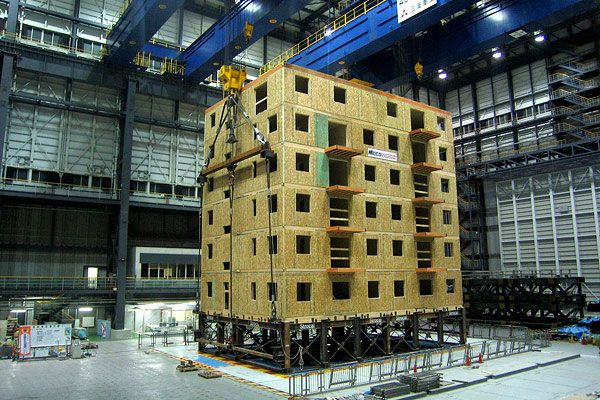In 2009, Simpson Strong-Tie participated in an unprecedented research event to highlight the importance of earthquake-resistant wood construction.
The event, the world’s largest earthquake test, was a collaborative Network for Earthquake Engineering Simulation project. It teamed academics, engineers, and industry researchers from around the world to subject a structure to what engineers refer to as the “maximum considered event” (MCE), a large, rare earthquake projected to occur, on average, approximately every 2500 years.
The test featured a full-scale, seven-story wood-framed condominium tower. The 40′ by 60′ tower included 23 one- and two-bedroom living units and two ground-level retail shops. It was built on the “E-Defense” (Earth-Defense) shake table in Miki City, Japan.
The tower, which weighed nearly 800,000 lb., was engineered with Simpson Strong-Tie solutions. The first floor was outfitted with steel special moment frames using Yield-Link® technology, and running along the height of the building above the steel frame were 63 Strong-Rod® anchor tiedown system (ATS) continuous rods securing the shearwalls. Throughout the building, our connectors secured the critical components of the seven-story structure.
The building was subjected to five tests — all modeled on the 1994 Northridge earthquake ground motions recorded at Canoga Park.
Phase 1: Seven-story structure
Test One: 60% of Northridge ground motion.
Test Two: 140% of Northridge ground motion.
After successful Phase 1 testing, the first-story steel SMFs were braced to remove their participation, effectively creating a six-story wood-only structure.
Phase 2: Six-story structure
Test Three: 60% of Northridge ground motion.
Test Four: 140% of Northridge ground motion.
Test Five: Intensity increased to 180% of Northridge ground motion (the MCE intensity).While there is not a direct correlation between MCE-level shaking and earthquake magnitude, shaking at that level could be thought of as the equivalent of perhaps a 7.5 magnitude event.
Colorado State University professor John Van De Lindt developed many of the performance-based building design procedures used on the NEESWood Capstone test. In a National Science Foundation webcast recorded shortly after the historic test, Van De Lindt said, “I think we had a very successful test. Basically, there was a 2,500-year earthquake we subjected the building to and it wound up [ . . . ]performing very, very well. We were expecting moderate damage, but it turned out that we had very, very light damage to the building. So in the end, after going in and inspecting, I think we proved exactly what we set out to prove.”
What Is Performance-Based Building Design?
Steve Pryor, Advanced Research manager at Simpson Strong-Tie, explained that the goal of this project was to “prove performance-based design can work to make wood structures behave reliably in an earthquake to whatever performance state is specified in the design.”
The basic concept of performance-based building design can be traced all the way back to ancient Babylonia. Hammurabi’s Code states, “a house should not collapse and kill people.”
Of course, the idea has evolved in the 38 centuries since someone chiseled King Hammurabi’s code into black basalt. The clearest definition came in 1982, in a paper by E.J. Gibson titled Working with the Performance Approach in Building. Gibson writes, “first and foremost, the performance approach is [. . . ] the practice of thinking and working in terms of ends rather than means. [ . . . ] It is concerned with what a building or building product is required to do, and not with prescribing how it is to be constructed.”
The NEESWood Capstone test was unique because it focused on wood. Historically, performance-based building design has been used primarily on steel and concrete projects. Van De Lindt explained, “This [design] has been developed for steel and concrete, and this is really the first time that there’s been any major development in this for wood structures. So, what I see is probably major developments over the next six months to two years in the design code. The [wood construction] industry within the US will be pushing to have buildings be five, six, even seven stories throughout the Pacific Northwest and all around the US as a result of this project.”
Pryor said, “It’s one thing to have a computer with high-powered processing project the results of a design, but until the rubber meets the road you don’t really know what’s going to happen. The project proved we can build a seven-story steel- and wood-framed structure, shake it hard, and have very little damage.”




